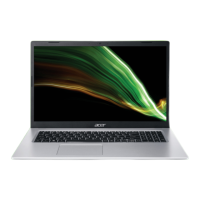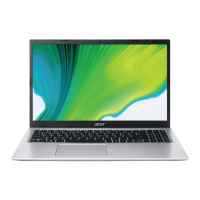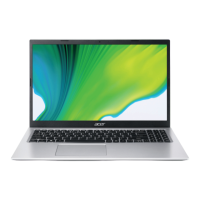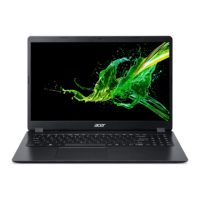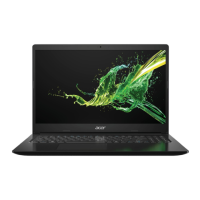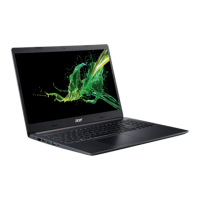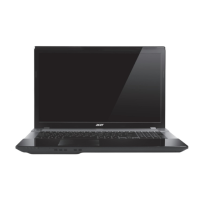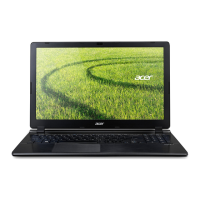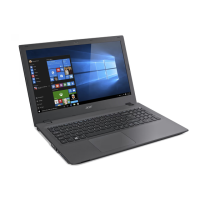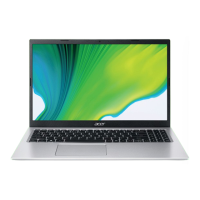Do you have a question about the Acer Aspire A317-33 and is the answer not in the manual?
Information on how to use your Acer notebook with setup and quick guides.
Guidelines for maintaining your computer's condition and proper usage.
Important precautions and recommendations for safe battery handling and charging.
Identifies key components visible on the notebook's screen.
Identifies key components visible on the notebook's keyboard.
Identifies ports and connectors on the left side of the notebook.
Identifies ports and indicators on the right side of the notebook.
Identifies components located on the bottom of the notebook.
Explains the function of Caps Lock, Num Lock, and Scroll Lock keys.
Describes keys that activate special functions like Sleep, flight mode, and brightness.
Details how to use function keys (Fn) for various shortcuts and operations.
Explains the functions of dedicated Windows keys on the keyboard.
Explains various gestures for navigation and interaction using the touchpad.
Guides on how to adjust touchpad sensitivity and other settings in Windows.
Steps to back up personal files using File History for data protection.
Instructions for backing up network drivers for future reinstallation.
Procedures for creating a full system backup for disaster recovery.
How to refresh the PC while retaining personal files and reinstalling Windows.
Steps to perform a factory reset, removing all personal data and apps.
Instructions on how to turn Bluetooth on or off on your computer.
Steps to pair and connect external Bluetooth devices to your computer.
Guidance on connecting to Wi-Fi networks for internet access.
How to connect to the internet using a wired Ethernet connection.
Instructions for connecting to the internet using a cellular data connection.
How to physically secure your laptop using a security lock cable.
Explains different types of passwords (Supervisor, User, Boot) for system security.
Details the process and rules for entering passwords on your computer.
Step-by-step guide to configure and use the fingerprint reader for Windows Hello.
How to adjust the boot order in the BIOS settings.
Instructions for setting Supervisor and other passwords in the BIOS.
Tips and steps to reduce power consumption and optimize battery life.
Information about the embedded Lithium battery and its behavior.
How to connect the AC adapter and charge the battery.
Procedure for conditioning a new battery for optimal performance.
How to view the current battery charge level.
What to do when the battery charge is low.
Steps to safely disconnect external accessories before moving.
Advice for moving the computer over short distances.
How to prepare the computer for transport, including Sleep mode.
Items to consider bringing for meetings, depending on duration and battery status.
Guidelines for moving the computer between home and office.
Specific considerations for traveling with the computer across countries.
Information about the reversible USB Type-C connector and its capabilities.
Steps to connect an external monitor to the computer.
How to connect audio devices like headphones and microphones.
Solutions for when the computer fails to power on or start.
Steps to resolve issues with a blank or unresponsive display.
How to fix problems related to sound output or muted volume.
Guidance on troubleshooting unresponsive keyboards or printers.
Helpful pointers for navigating and utilizing Windows 10 features.
Instructions on how to check for and install system updates.
General advice and approaches for resolving system problems.
Lists common error messages and their corrective actions.
Vital steps to safeguard your computer against online threats and viruses.
Information on choosing an ISP and different connection types.
How to use web browsers and access the internet.
Details on pre-installed security software and online protection.
| Processor | Intel Celeron N4500 |
|---|---|
| RAM | 4GB DDR4 |
| Storage | 128GB SSD |
| Graphics | Intel UHD Graphics |
| Weight | 2.6 kg |
| Wireless | Wi-Fi 5 (802.11ac), Bluetooth 5.0 |
| Display | 17.3-inch HD+ (1600 x 900) |
| Operating System | Windows 11 Home |
| Battery | 36Wh |
| Ports | 2 x USB 3.2, 1 x USB 2.0, 1 x HDMI, 1 x Ethernet (RJ-45), 1 x 3.5mm audio jack |
